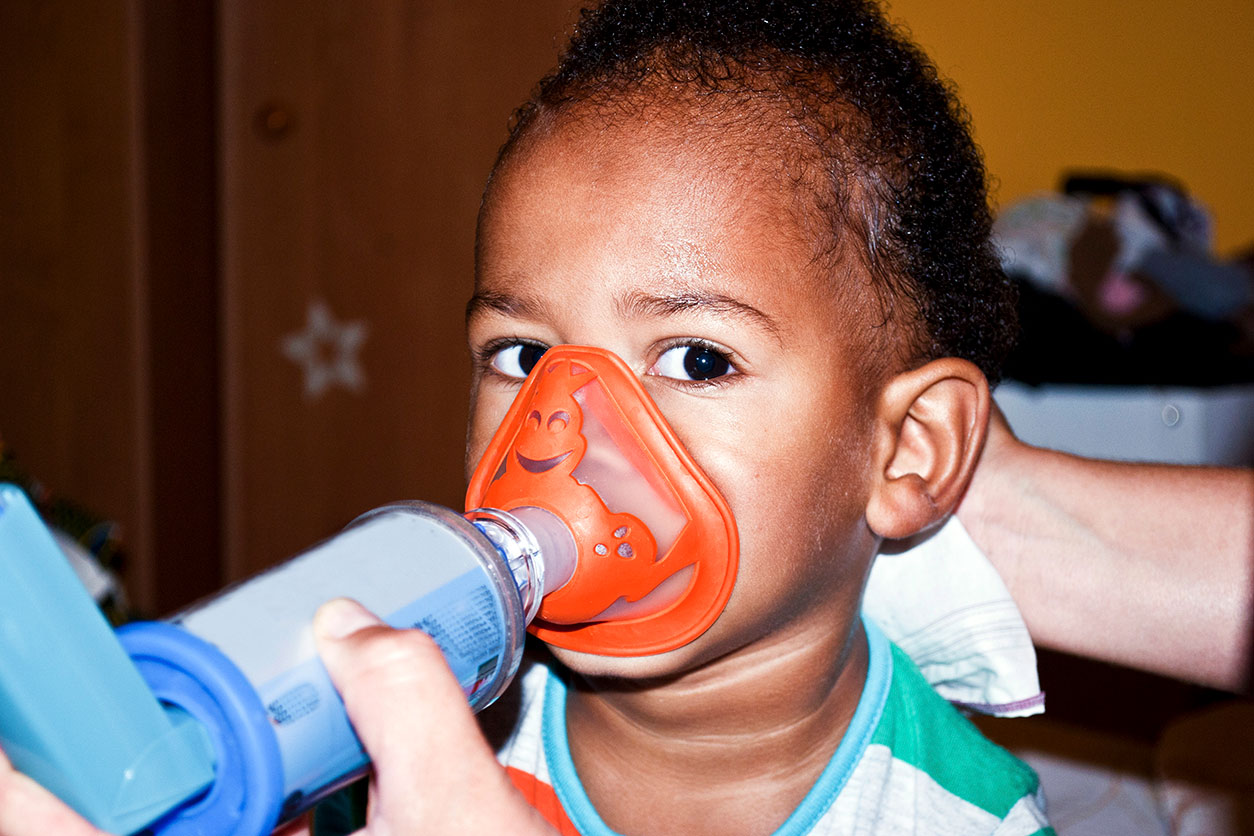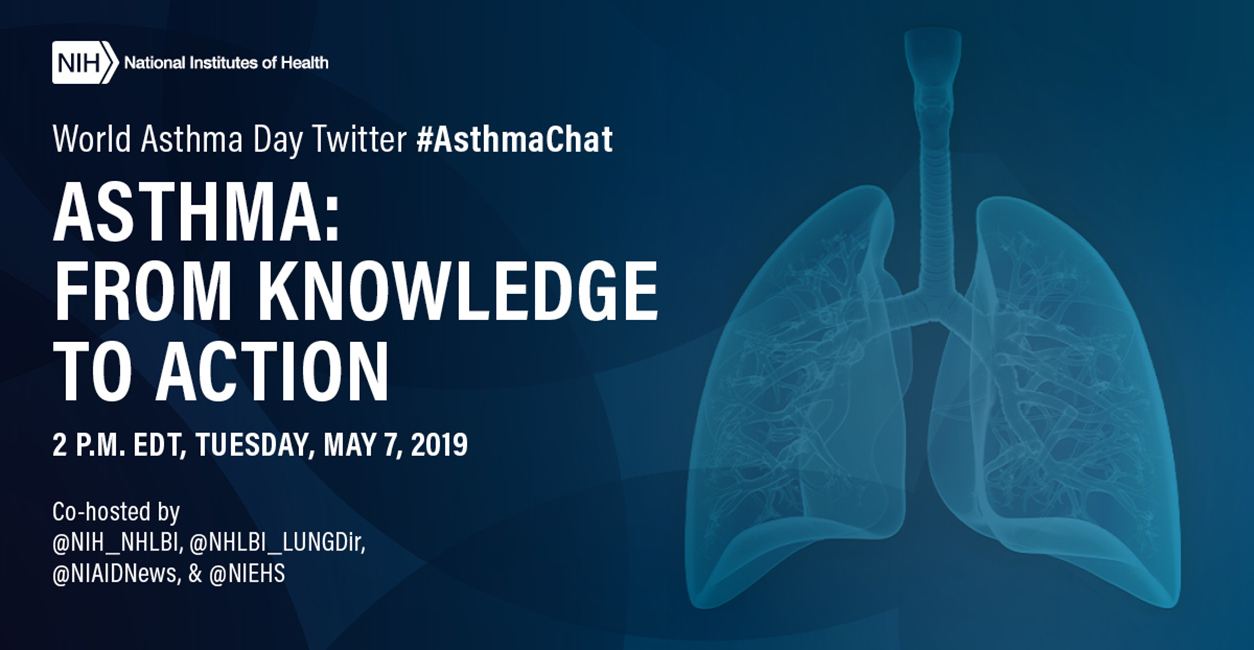On World Asthma Day 2019, the National Institutes of Health (NIH) stands with patients, families, advocates, researchers, and health care professionals around the globe to raise awareness about this common chronic respiratory disease.
In 2016, asthma affected 26 million Americans and nearly 340 million people worldwide, according to the Global Burden of Disease study. The disease can profoundly affect quality of life and financial and emotional health, and is a major cause of missed time from school and work. Severe asthma attacks may require emergency room visits and hospitalizations, and can be fatal.
Asthma flares result when the airways of the lungs become inflamed by a variety of triggers in the air, such as indoor pollutants and allergens from dust mites and mold, as well as outdoor air pollution. This inflammation narrows and obstructs the airways, causing symptoms like wheezing, coughing, chest tightness, and difficulty breathing.
NIH-funded research has greatly increased knowledge of asthma and has led to better treatment and prevention options. Implementing what we know in clinical and community settings, however, still needs urgent attention.
Putting into practice proven strategies for asthma prevention, control, and care not only will help reduce the burden of the disease, it also will help address health disparities that have resulted in asthma’s disproportionate impact on racial and ethnic minorities and families living at or below the poverty line.
Three NIH institutes support and conduct studies on asthma — the National Heart, Lung, and Blood Institute (NHLBI); the National Institute of Allergy and Infectious Diseases (NIAID); and NIEHS. This research portfolio reflects the complexity of medical, environmental, and social and economic factors that influence the causes, management, treatment, and prevention of this condition.
NIH-supported scientists continue to work to prevent and treat asthma every day of the year. This May, Asthma Awareness Month, NIH honors the children and adults who face the daily challenges of asthma, and we renew our commitment to ensure that our research discoveries turn into improved health outcomes for all of them.
NHLBI — personalized medicine, complex disease
The NHLBI’s Division of Lung Diseases, which is celebrating its 50th anniversary this year, leads the efforts to understand the biology of asthma development, progression, and severity, and to optimize treatment for patients. Despite significant research strides, many people continue to have poorly controlled asthma, which underscores the importance of improving the adoption of current evidence-based interventions and developing new ones.
As it has improved therapies and prevention for patients, NHLBI’s research has contributed to a better understanding of asthma as a complex disease with a broad range of genetic and biological variability. This heterogeneity affects individual patients’ responses to triggers and treatment, posing a challenge to managing the condition and calling for more personalized methods.
Funded by the NHLBI, the Precision Interventions for Severe and/or Exacerbation Prone Asthma Network will be conducting clinical trials to identify personalized medicine approaches that treat severe asthma more effectively. It has established 10 centers to test a series of treatments approved by the U.S. Food and Drug Administration based on each patient’s specific biology or biomarkers. Recruitment will begin this year.
NHLBI also funds the Asthma Empowerment Collaborations to Reduce Childhood Asthma Disparities. This program supports clinical trials to evaluate Asthma Care Implementation Programs that provide comprehensive care for children at high risk of poor asthma outcomes, such as low-income minority children. The program aims to provide integrated care for children in all spheres of their lives and to create programs that will be sustainable after the grant support ends.
Additionally, NHLBI’s Center for Translation Research and Implementation Science (CTRIS) serves as a focal point within the Institute to plan, foster, and support research to identify the best strategies for ensuring successful adoption of evidence-based interventions.
 Among NIH-supported research on childhood asthma are NHLBI-funded collaborations to evaluate programs that provide comprehensive care for children at high risk of poor asthma outcomes, such as low-income minority children.
Among NIH-supported research on childhood asthma are NHLBI-funded collaborations to evaluate programs that provide comprehensive care for children at high risk of poor asthma outcomes, such as low-income minority children.NIAID — cities, households, and the common cold
NIAID’s Inner-City Asthma Consortium (ICAC) studies the causes of asthma in urban children as part of its effort to better understand the immune responses that lead to asthma. This work enables development of improved prevention strategies and treatments. ICAC oversees nine clinical research sites in the United States, and its observational studies, clinical trials, and related research explore the convergent risks of allergen exposure, allergen sensitization, and viral respiratory infections.
Programs that aim to decrease exposure to household allergens, such as dust mites, cockroaches, and rodents, decrease asthma symptoms and health care visits in children with allergic asthma. Paradoxically, early life exposure to certain allergens and bacteria may protect against asthma. The Urban Environment and Childhood Asthma study showed that children exposed to high indoor levels of pet and pest allergens during infancy have a lower risk of developing asthma by 7 years of age.
ICAC research established that omalizumab can prevent most asthma exacerbations in the autumn, many of which are caused by the common cold. More recently, ICAC investigators have unveiled pathways in the development of asthma exacerbations associated with the common cold, opening the possibility of identifying further therapeutic agents to prevent exacerbations.
In addition, a comprehensive study by the consortium found that inflammation of the mucous membrane of the nose, known as rhinitis, is rampant in urban children with asthma. It is also very difficult to control and strongly linked to asthma symptoms and attacks.
NIEHS — environment and immune system
At NIEHS, scientists study asthma by looking at the interplay between the environment and the immune system. The Natural History of Asthma with Longitudinal Environmental Sampling (NHALES) study at the NIEHS Clinical Research Unit is examining how the environment affects asthma symptoms.
During the past 40 years, NIEHS has supported some of the most important air pollution and asthma research studies. NIEHS research has shown that air pollution makes people with asthma sicker and worsens their breathing. In addition, some forms of air pollution, especially diesel and traffic-related pollution, may also cause children to develop asthma.
NIEHS-funded research from the Cincinnati Childhood Allergy and Air Pollution Study has shown the important role of ambient air pollution, including roadside pollution, as a cause of asthma and of its exacerbation in the United States.
The NIEHS Environmental Cardiopulmonary Disease Group focuses its research on the role of the environment in the origin of asthma and allergic diseases. In addition to large national studies, the group has led environmental interventions to reduce indoor allergen levels in homes, which has improved scientists’ understanding of indoor allergen and endotoxin exposures and their role in allergic disorders.
The NIEHS/Environmental Protection Agency Children’s Environmental Health and Disease Prevention Research Centers study factors that impact children’s health, with several centers focusing on asthma. For example, the Children’s Center at Johns Hopkins University found that vitamin D protects against pollution-induced asthma.










